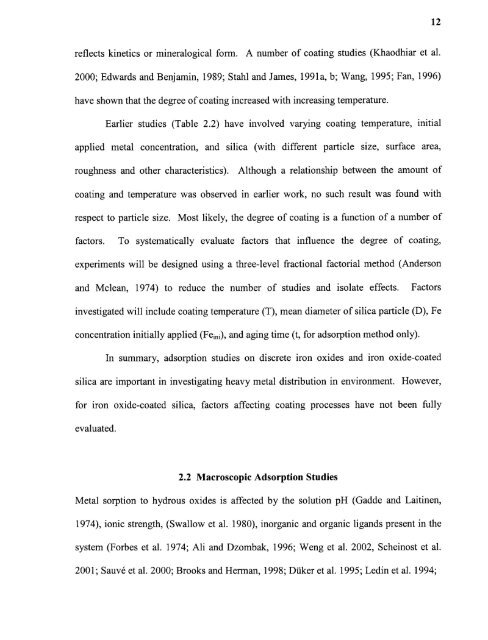Heavy metal adsorption on iron oxide and iron oxide-coated silica ...
Heavy metal adsorption on iron oxide and iron oxide-coated silica ...
Heavy metal adsorption on iron oxide and iron oxide-coated silica ...
You also want an ePaper? Increase the reach of your titles
YUMPU automatically turns print PDFs into web optimized ePapers that Google loves.
12reflects kinetics or mineralogical form. A number of coating studies (Khaodhiar et al.2000; Edwards <strong>and</strong> Benjamin, 1989; Stahl <strong>and</strong> James, 1991a, b; Wang, 1995; Fan, 1996)have shown that the degree of coating increased with increasing temperature.Earlier studies (Table 2.2) have involved varying coating temperature, initialapplied <str<strong>on</strong>g>metal</str<strong>on</strong>g> c<strong>on</strong>centrati<strong>on</strong>, <strong>and</strong> <strong>silica</strong> (with different particle size, surface area,roughness <strong>and</strong> other characteristics). Although a relati<strong>on</strong>ship between the amount ofcoating <strong>and</strong> temperature was observed in earlier work, no such result was found withrespect to particle size. Most likely, the degree of coating is a functi<strong>on</strong> of a number offactors. To systematically evaluate factors that influence the degree of coating,experiments will be designed using a three-level fracti<strong>on</strong>al factorial method (Anders<strong>on</strong><strong>and</strong> Mclean, 1974) to reduce the number of studies <strong>and</strong> isolate effects. Factorsinvestigated will include coating temperature (T), mean diameter of <strong>silica</strong> particle (D), Fec<strong>on</strong>centrati<strong>on</strong> initially applied (Feini), <strong>and</strong> aging time (t, for <str<strong>on</strong>g>adsorpti<strong>on</strong></str<strong>on</strong>g> method <strong>on</strong>ly).In summary, <str<strong>on</strong>g>adsorpti<strong>on</strong></str<strong>on</strong>g> studies <strong>on</strong> discrete ir<strong>on</strong> <strong>oxide</strong>s <strong>and</strong> ir<strong>on</strong> <strong>oxide</strong>-<strong>coated</strong><strong>silica</strong> are important in investigating heavy <str<strong>on</strong>g>metal</str<strong>on</strong>g> distributi<strong>on</strong> in envir<strong>on</strong>ment. However,for ir<strong>on</strong> <strong>oxide</strong>-<strong>coated</strong> <strong>silica</strong>, factors affecting coating processes have not been fullyevaluated.2.2 Macroscopic Adsorpti<strong>on</strong> StudiesMetal sorpti<strong>on</strong> to hydrous <strong>oxide</strong>s is affected by the soluti<strong>on</strong> pH (Gadde <strong>and</strong> Laitinen,1974), i<strong>on</strong>ic strength, (Swallow et al. 1980), inorganic <strong>and</strong> organic lig<strong>and</strong>s present in thesystem (Forbes et al. 1974; Ali <strong>and</strong> Dzombak, 1996; Weng et al. 2002, Scheinost et al.2001; Sauvé et al. 2000; Brooks <strong>and</strong> Herman, 1998; Düker et al. 1995; Ledin et al. 1994;
















